|
|
|
Sort Order |
|
|
|
Items / Page
|
|
|
|
|
|
|
| Srl | Item |
| 1 |
ID:
111801
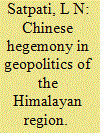

|
|
|
| 2 |
ID:
145378
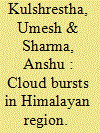

|
|
|
|
|
| Summary/Abstract |
The Himalayan range is the youngest with highly active mountains on the earth. These mountains have assumed a greater importance by regulating the weather of northern Indian subcontinent since times immemorial (Kumar et al., 2010). However, the inherent geological and anthropogenic influences has increased its susceptibility of these ranges to the hazards of landslides, failure of natural dams, glacial lakes outburst, flash flood, debris flows and cloud bursts (Kumar et al., 2010).
|
|
|
|
|
|
|
|
|
|
|
|
|
|
|
|
| 3 |
ID:
128513
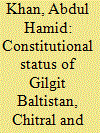

|
|
|
|
|
| Publication |
2013.
|
| Summary/Abstract |
Before the partition of the Indian sub-continent, the British handed over the tiny states including Yasin, Punial, Gupis, Ishkoman, Gilgit, Nagar, Hunza, Astore and Chilas to the Maharaja of Kashmir. Chilas was under the suzerainty of Yasin even after 1947. Before 1860, Mastuj (now part of Chitral), Gupis and Ishkoman were also integral parts of Yasin. After the murder of British spy Col. George Hayward by the Yasin ruler Mir Wali in 1873, differences between the State of Yasin and the British government had deepened. The British reacted by separating Mastuj, Koh Ghizer, Gupis and Ishkoman from Yasin. Rundu, Kharmang, Skardu, Ladakh and Astore remained under the direct control of Maharaja of Jammu and Kashmir. Before the partition of India, the Maharaja of Kashmir, on 1 August 1947, took over the administration of the entire Gilgit-Baltistan, i.e., former Gilgit Wazarat north of the Indus and all political districts. The area together with Bonji formed the Gilgit frontier province. Maharaja of Kashmir appointed Brigadier Ghansara Singh as the Governor, and also sanctioned the budget for the Gilgit frontier province.
|
|
|
|
|
|
|
|
|
|
|
|
|
|
|
|
| 4 |
ID:
145394
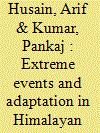

|
|
|
|
|
| Summary/Abstract |
Climate change is one of the most complex and difficult challenges for the Himalayan countries. Scientific data to monitor climate and environment change are lacking in the Himalayas region. For example IPCC has identified Hindu-kush Himalayas region as the data deficient. Long-term research and comprehensive data are needed to plan adaptation and mitigation program to deal with future changes.
|
|
|
|
|
|
|
|
|
|
|
|
|
|
|
|
| 5 |
ID:
135489
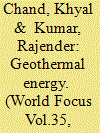

|
|
|
|
|
| Summary/Abstract |
In the other words we can say that geothermal sites in India have a great potential to produce electricity and which can supplement her current and prospective energy crisis. It can contribute great potential and huge environmental benefits India must seriously put efforts on harnessing her least explored alternative source of energy. Therefore geothermal power can become a valuable source of energy if it will properly harness in our country.
|
|
|
|
|
|
|
|
|
|
|
|
|
|
|
|
| 6 |
ID:
128505
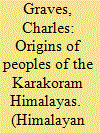

|
|
|
|
|
| Publication |
2013.
|
| Summary/Abstract |
The scholarly search for the origin of the people of this region often falls victim to the complex religious history of the area. If we leave aside the question of the religions of the people it may be possible to determine which 'peoples' at an early age inhabited the region up until recently called 'The Princely State of Jammu and Kashmir'. At 3,500 years ago (at 1,500 BPE - 'before the Present Era') the Indo- Aryans had already entered the Ganges plain and presumably there were some other elements of migrations from Central Asia which reached the more northerly areas of India called Kashmir. Moreover, it is possible some 'aboriginal' groups from Rajasthan and Gujarat had penetrated Kashmir as well as other parts of the sub-continent. Also some 'Dravidian' speakers (arriving in the sub-continent circa. 2,500 BPE) could have come to Kashmir.
|
|
|
|
|
|
|
|
|
|
|
|
|
|
|
|
| 7 |
ID:
148903
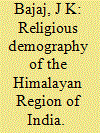

|
|
|
| 8 |
ID:
128508
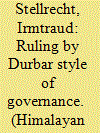

|
|
|
|
|
| Publication |
2013.
|
| Summary/Abstract |
In May 2009, in a small chat room in the Hunza Valley (in Northern Areas of Pakistan), a heated debate ?ared up over an old photograph. It showed Mir Muhammad Nazim Khan, ruler of Hunza State, from 1892
to 1938, and his Wazir, Humayun Beg, in ceremonial attire at the Imperial Coronation Durbar at Delhi in 1903. The opinions offered by the participants ranged from appreciation for great leaders of the past to their
utter condemnation as colonial 'devils' and exploiters. In fact, the photo conveys various messages. For me, first of all, it shows the integration of the Hunza Mir into a colonial hierarchy. Second, and more generally
speaking, it draws our attention to the world of durbars or 'ceremonial gatherings' in colonial India. Muhammad Nazim Khan was actively involved in this world.' He participated in two imperial durbars at Delhi, and every year he also attended a durbar, known as the Ialsa.
|
|
|
|
|
|
|
|
|
|
|
|
|
|
|
|
| 9 |
ID:
128516
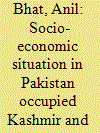

|
|
|
|
|
| Publication |
2013.
|
| Summary/Abstract |
in 1947 the combined population of Pak-occupied Kashmir (POK) and the 'Northern Areas" of Gilgit and Baltistan was 25 percent of the total population of ]&K State. Today this percentage has gone upto 33 percent of the total population of ]&K. The per decade growth rate of the population on both sides of the Line of Control (LoC) has remained the same. The steep rise in population in POK is because of the heavy in?ux of Punjabi Muslims from the plains. Today the Punjabi Muslims outnumber the Kashmiris in POK by a ratio of 5:1. Not only is 'Azad Kashmir' not Azad (free) - it hardly remains Kashmir except in name. Taking a cue from what the Chinese did in Tibet - the Pakistani Army has followed suit in POK - it has flooded the area with Punjabi Muslims to outnumber the Kashmiris in their own land. Most of the new Punjabi Muslim settlers were former soldiers of the Pakistani Army sent on a simple mission -
colonise Pakistan Occupied Kashmir, stamp out its Kashmiri identity all together, make it 'Pak' (which in Urdu means pure) by making it fully Punjabi. The grass always looks greener on the other side of the hill. It is a great tragedy that the strident propaganda of the jihadis has created a smoke screen that obfuscates the simple truth. Today we need to look across the LoC to see what is the reality. Not only is 'Azad Kashmir' no longer Kashmiri anymore in terms of demographic numbers, it never really was 'Azad' or free. In 1991, POK Prime Minister, Mumtaz Rathore was dismissed, arrested and flown by helicopter to a Pakistani prison.
|
|
|
|
|
|
|
|
|
|
|
|
|
|
|
|
| 10 |
ID:
066255
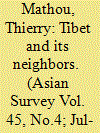

|
|
|
|
|
| Publication |
2005.
|
| Description |
p503-521
|
|
|
|
|
|
|
|
|
|
|
|
|
|
|
|
|
|
|
|
|